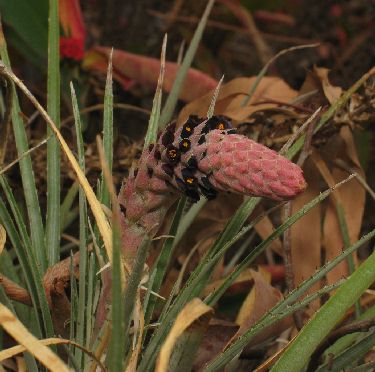
Derek Butcher ... "Research in Bolivia (See J. Brom. Soc.52(4): pages 158-65. 2002) has found that there is such a thing as Puya tunarensis which others had confused with Puya humilis. At the same time they found that with the information from Puya butcheriana there was reason to broaden the concept of Puya humilis and treat Puya butcheriana as a synonym. So alas I am no more. But do not worry too much because the holotype in Selby Botanical Gardens will still have my name on it and I will survive as a dried specimen!"
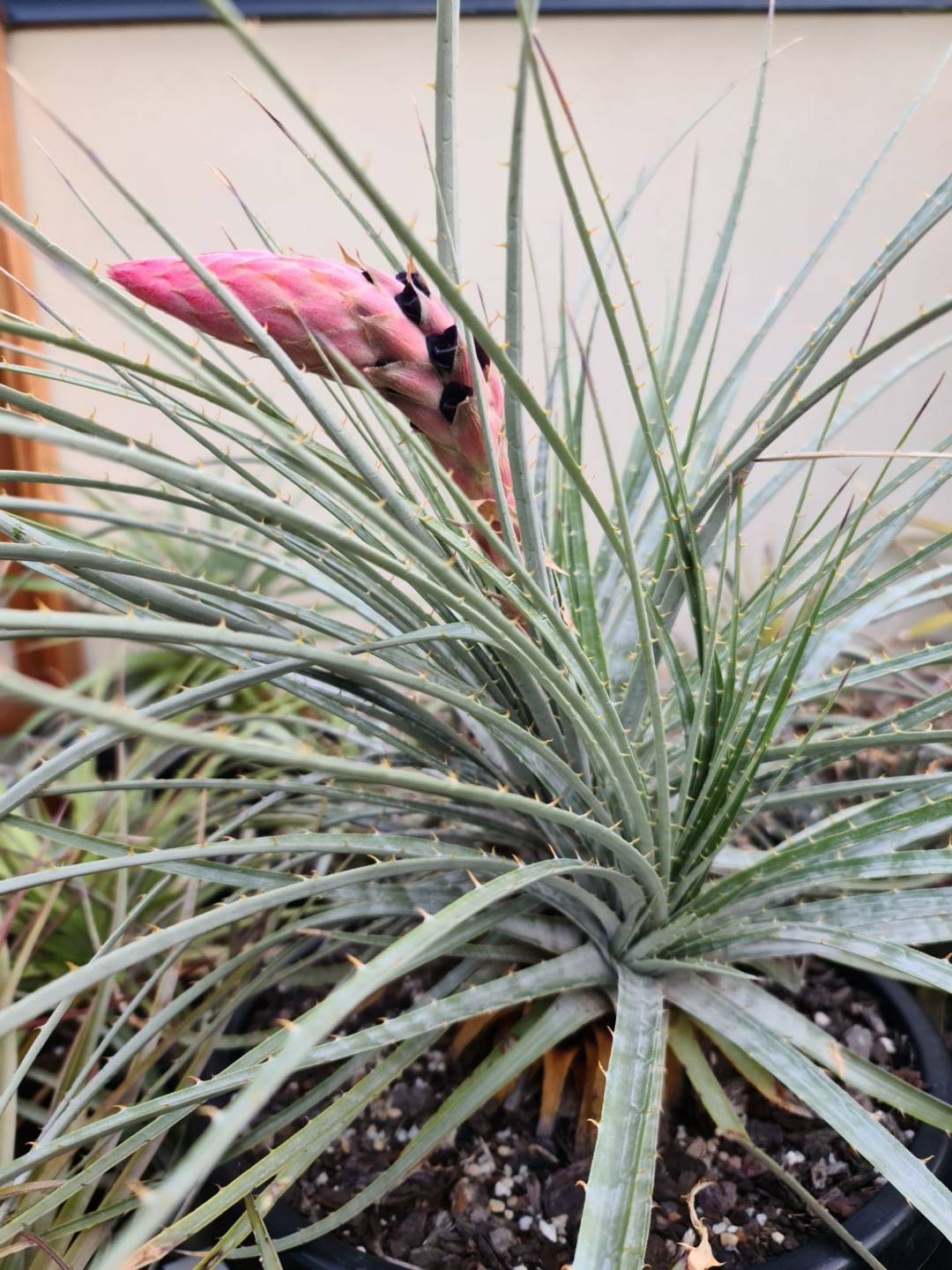
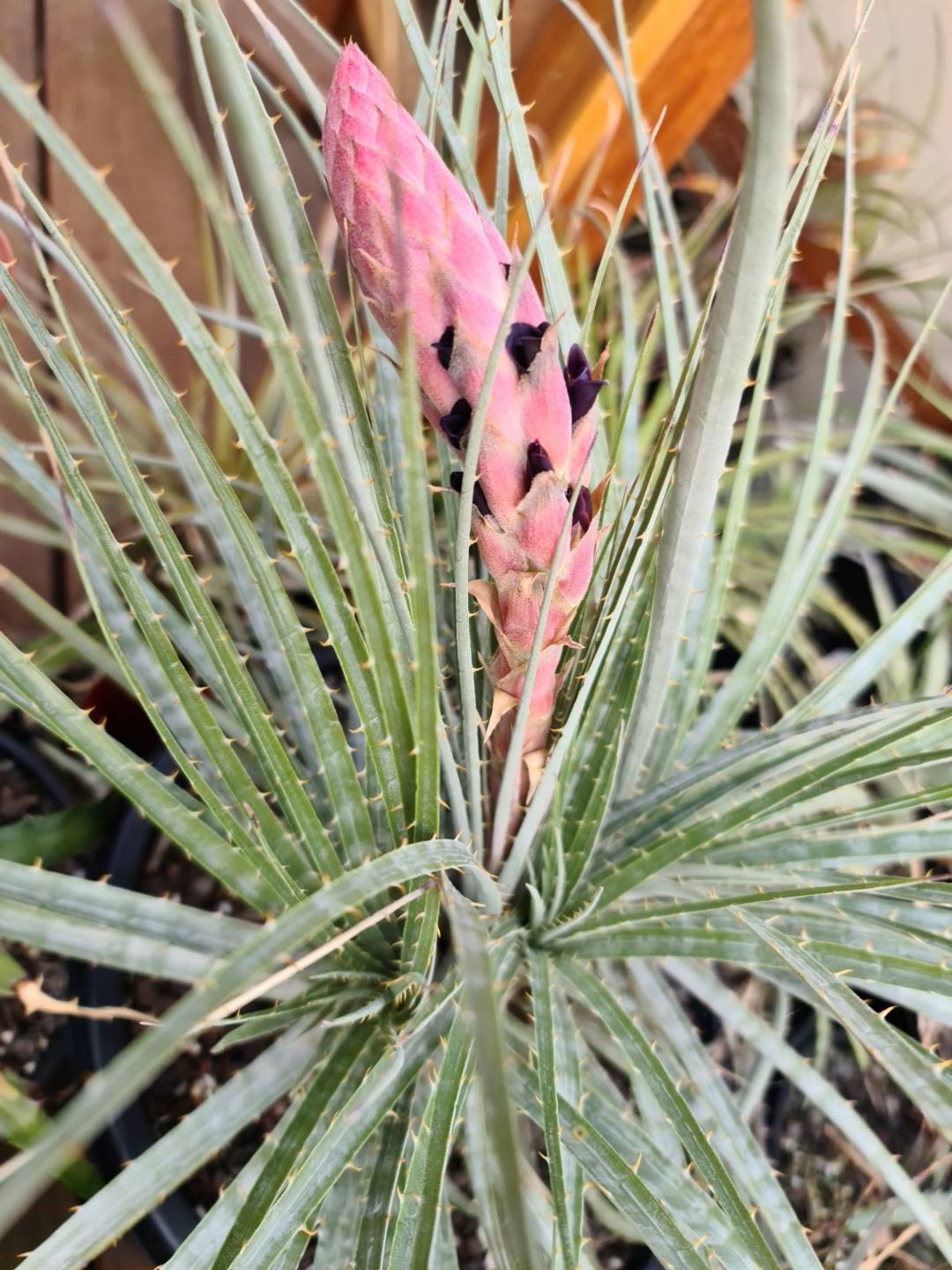

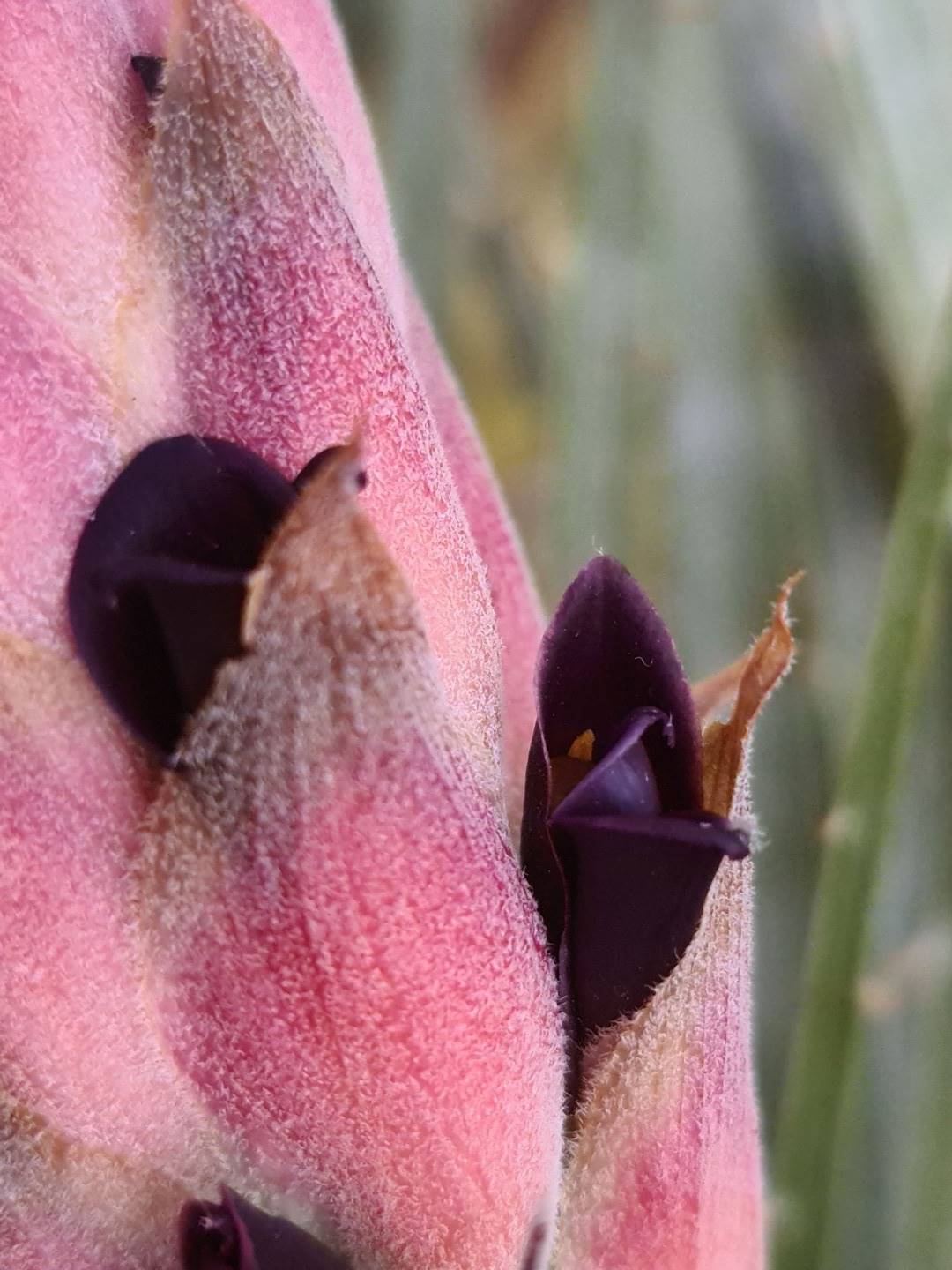
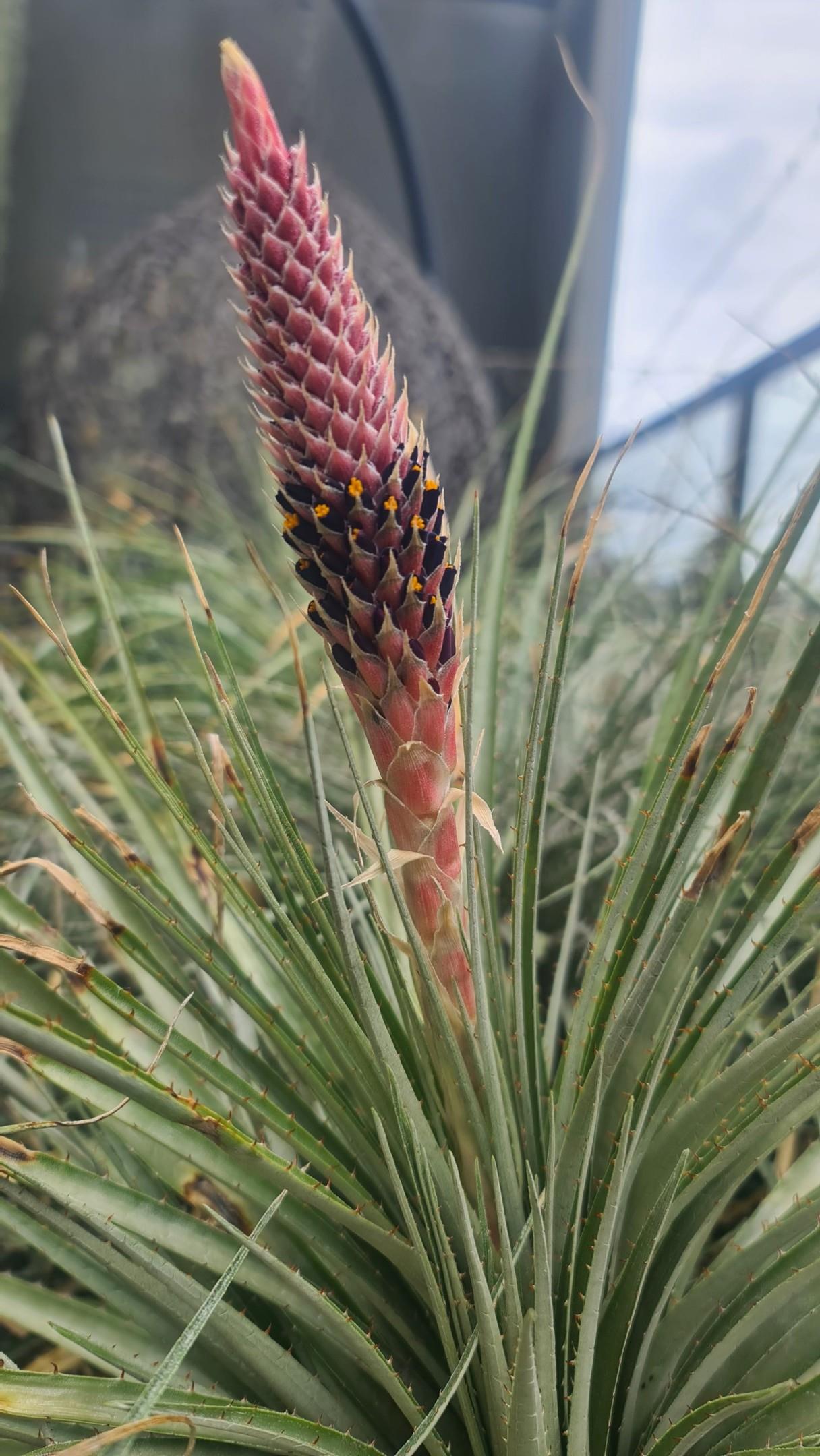
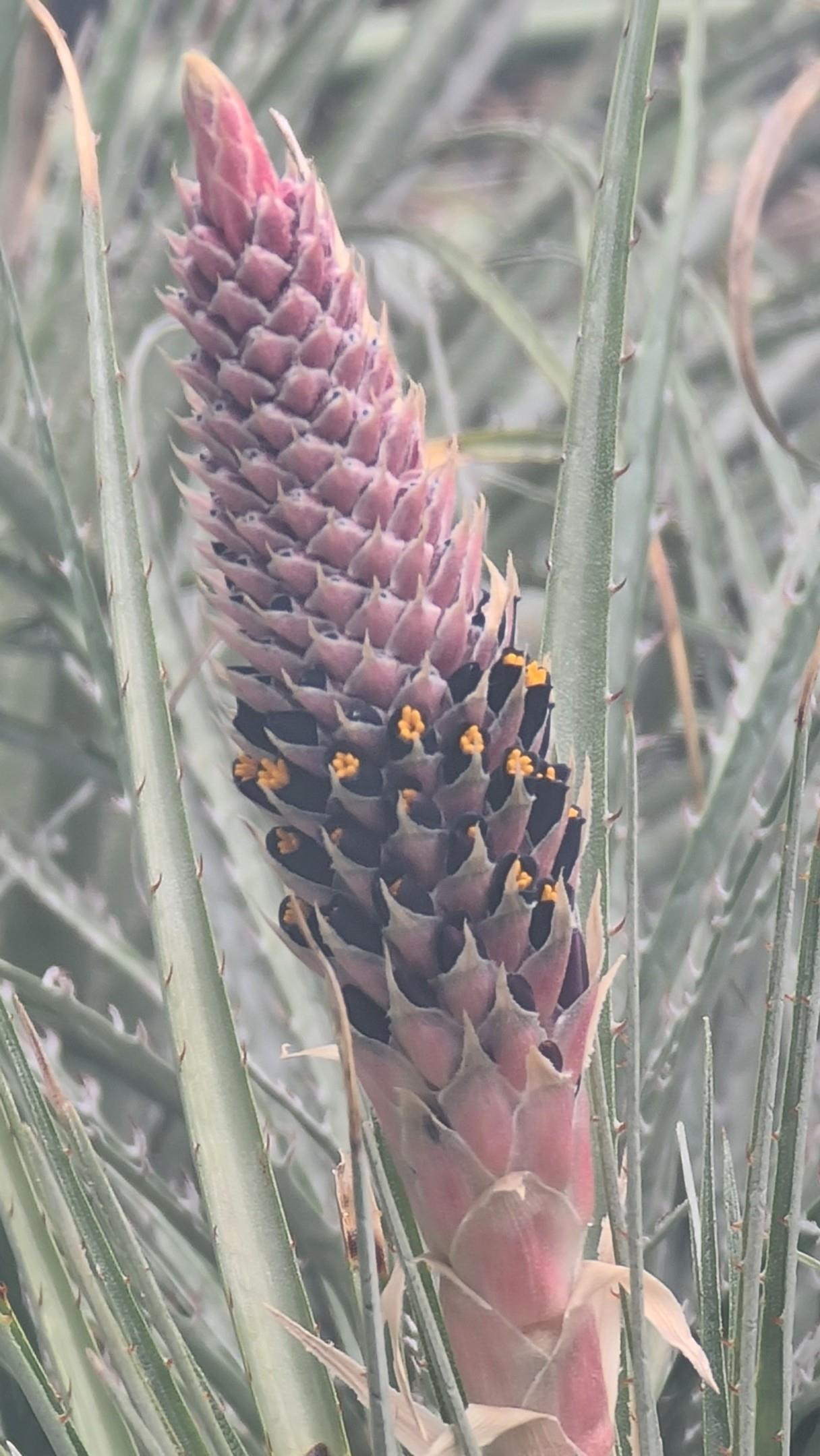
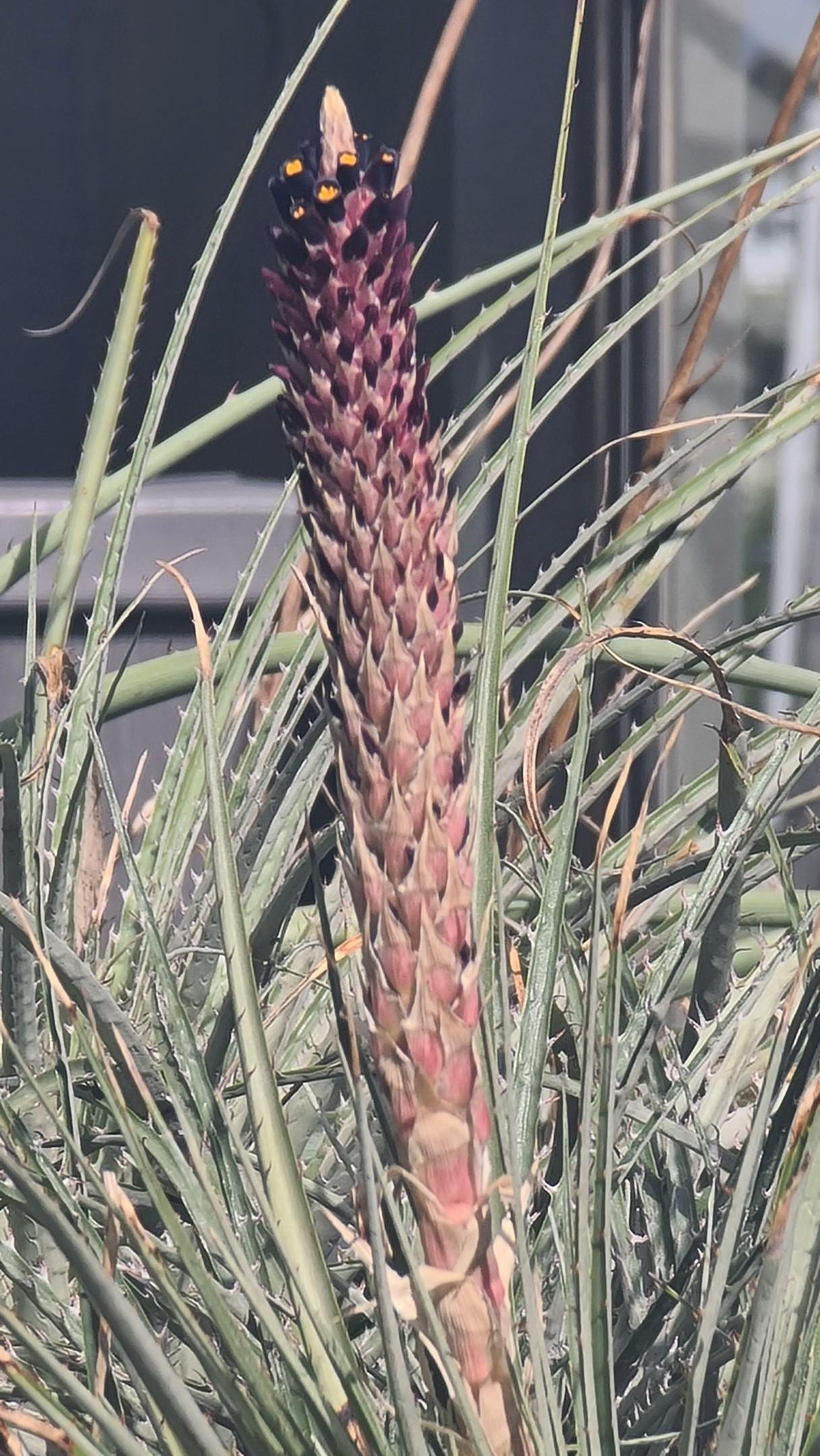
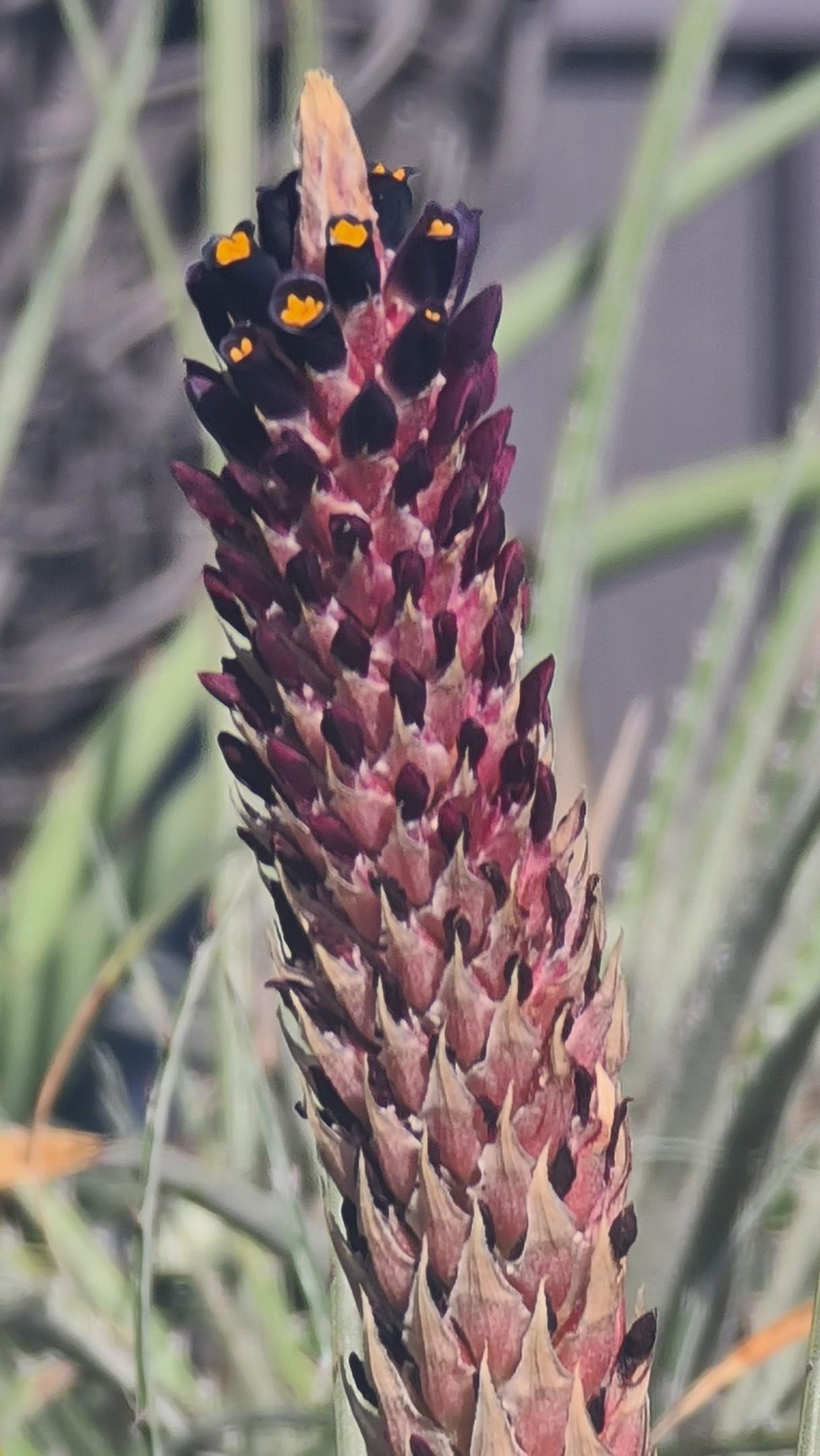

Abstract: The confusion that existed with regard to the correct identity of Puya humilis Mez and P. tunarensis Mez is clarified. A region near the Cotacajes river, in the Department of Cochabamba, Bolivia, between 1,300 and 1,400 m, is identified as the type locality of P. tunarensis (and as well as of P. kuntzeana). Ecology and geographical records of both species are presented. The relevant characters are explained supporting that both taxa really are distinct species. A distribution map, ecogram and photographs of both species are provided. P. butcheriana H. Luther is proposed as a new synonym of P. humilis Mez.
Introduction
Since the discovery of Puya tunarensis and P. humilis by Otto Kuntze, in 1892, confusion has existed with regard to the correct identity of both species. One has been called the other and vice versa. This confusion involved many botanists and collectors who tried to promote the knowledge on Bolivian bromeliads: e.g., Smith & Downs (1974), Luther (1995), Kromer et al. (1999) and lbisch & Vasquez (2000).
In their key, Smith & Downs (1974) clearly separated both species as being distinctive with regard to the floral bract that is erect in P. humilis and recurved in P. tunarensis. However, this character is not consistent in P. humilis which may show recurved scape bracts and basal floral bracts like P. tunarensis. Thus, Smith and Downs (1974) determined the specimens Cardenas 2372, 3580, Cardenas et al. 7639 and Foster 2555 as P. tunarensis - although they belonged to P. humilis.
On the one hand, among others, they did not take into account habitat characteristics like the altitude of the localities of the types of both species, and of course they were not familiar with the geography of the Cochabamba region. On the other hand, the original description of the type locality of P. tunarensis is confusing - leading to a somewhat misleading epithet.
Both holoypes are deposited at the New York Botanical Garden and were revised by the first author in November of 2001. The herbarium label of the holotype of P. humilis says: "Bolivia 3,000 m plain near Sacaba, 13-21 April 1892." This site can be identified easily. Sacaba, some 12 km to the east of the city of Cochabamba, is surrounded by mountains that are higher than 3,000 m. There the species is found with abundant populations. In the case of P. tunarensis the voucher label indicates as locality: "Bolivia Tunari mountains 1,300 m May 92 (1892)." It is this locality that created confusion because the city of Cochabamba is located at an altitude of about 2,500 m, and the Tunari Mountains, northwest to northeast of the city, reach an altitude of more than 5,000 m (Tunari summit). Thus, the question was: Where in the Tunari Mountains could a site exist of about 1,300 m as indicated by Kuntze? Or was he just wrong about the altitude?
The answer was found during a trip of the first author, in June 2001, participating in a botanical expedition to the Cotacajes valley that is the border between the Departments of Cochabamba and La Paz. The Cotacajes valley is one of the rather isolated dry inter-Andean valleys that are inserted in the humid forests of the Yungas ecoregion. Recently, an endemic bromeliad was discovered in this valley: Fosterella cotacajensis Kessler, Ibisch & Gross (Kessler et al. 1999).
Going from Cochabamba, this valley is reached crossing the Tunari Mountains northwestwards. And there, in the vicinity of the village of Cotacajes, on steep rocky escarpments, we found two species of Puya: the first rather large, to 1.5-2 m high, with large green leaves and reddish tips, erect scape, covered by large bracts, and a compact and multiflowered inflorescence. This species turned out to be P. kuntzeana, also named by Mez in honor of its first collector Otto Kuntze! Obviously, Kuntze had traveled to the Cotacajes valley. The second species was smaller and presented clear green leaves, cylindrical inflorescences with recurved apices of the floral bracts. These characters fit well to P. tunarensis. The fact that these two species occurred together - at an altitude of more or less 1,300 m (!) - confirmed to us that we had arrived at the type locality of both P. tunarensis and P. kuntzeana, not in the Tunari Mountains as vaguely indicated by Kuntze, but on their other side, northwestwards of the Tunari summit. This interpretation is confirmed by the label of the P. kuntzeana type: "Bolivien 1300 m, Tunari 4/5/1892". The three species P. kuntzeana, P. tunarensis and P. humilis were discovered by Otto Kuntze in 1892. Mez identified them as new species in 1894 and described them in 1896.
Distribution of Puya humilis and Puya tunarensis
Puya humilis is endemic to Bolivia but has a rather large range, in altitudes between 2,500 and 3,900 m, more or less associated with the upper headwaters of the Rio Grande river system (departments of Cochabamba, Chuquisaca and Potosi). P. tunarensis is restricted to the isolated and narrow Cotacajes valley, between the Cochabamba and La Paz departments, at an altitude of 1,200 to 1,400 m . The species are separated by the at least 4,500 m high Cochabamba/Tunari Mountain chain.
Recorded specimens
Puya humilis Mez, DC. Monogr. Phan. 9: 498. 1896.
Puya werdermannii Harms. Notizbl. Bot. Gart. Berlin 10: 793. 1929. Tipo: Bolivia: NE sierra de Cochabamba, Incachaca, Chuquechampi to Cuchicancha, Jul. 1926, Werdermann 2006 (B fotog. 11423, F).
Puya butcheriana H. Luther, Selbyana 16(2): 235-238. 1985. Syn. nov. Type: unknown origin, possibly Bolivia or Peru, 24 January 1992, D. Butcher s.n. (Holotype: SEL).
Type: BOLIVIA: 3,000 m (plain near) Sacaba, 13-21 Abr. 1892, Kuntze s.n. (Holotype: NY!).
Other records from Bolivia:
COCHABAMBA: Prov. Arani: Toralapa, January 1946, Ccirdenas 3580 (US); ibid.: between Vacas and Rodeo, approximately 17°42'S, 65°45'W, 3,400m, on rocky crevices of dry, alpine scrub vegetation, 20 April 1987, G.S. & U Varadarajan & J Brandbyge 1451 (LPB); ibid.: 1.5 km, road from Alalay to Mizque, 17º43'S, 65º39'W; 3,750 m, 23 July 1998, P. & C. Ibisch 98.0103 (LPB); ibid.: 1.5 km, road from Arani to Mizque, 15 km after turn-off to Vacas, 17°42'S, 65°39'W, 3,900 m, 7 August 1993, P. & C. Ibisch 93.0563 (LPB); ibid.: Chulku Mayu Community, 3,700 m, Polylepis forest, montane forest, 2 March 1991, I. Hensen 1223 (LPB); ibid.: Koari, km 90 old road between Cochabamba and Santa Cruz, 3,400 m, 28 December 1999, R. Vasquez 3500 (VASQ); Prov Carrasco: Quirusillani to Totora, April 1943, Cardenas 2372 (GH); ibid.: Siberia, between Comarapa and Pojo, 11 January 1965, Vogel 468 (US), ibid.: nearby Montepuncu, on the road to Sehuencas, 17º33'S, 65º 17'W; 2,800 m, 27 June 1993 (flowers in cultivation, 1 October 1993), P. & C. Ibisch 93.0486 (LPB). Prov Chapare: 3,500m, 17º24'S 65º52'W, 23 Oct. 1985, JC. Solomon 14509 (MO); ibid.: between Melga and Waganki 3,240 m, terrestrial on rocky slopes, 5 February 1999, R. Vasquez 3160 (VASQ). Prov. Esteban Arce: from Anzaldo to Tarata, 9 January 1943, Cardenas, Cutler & Gandarillas 7639 (US). Prov Mizque: Cocha (Cocha-Cocha) to Vila Vila, 15 November 1948, Foster 2555 (US). CHUQUISACA: Prov. Oropeza: Guerraloma, Sucre, February 1949, Cardenas 4128 (US); north of Presto, 3070 m, "ckayara-kayanta ", 29 August 1980, G. Muhlbauer s.n. (LPB); ibid.: track from La Recoleta to the "Cristo", Eucalyptus plantation, approximately 2,900 m, 25 July 1991, P. & C. Ibisch 25072 (LPB). POTOSI: Tagua Comuno, 15 km southwards from Potosi, 25 March 1936, West 6370 (UC); ibid.: Prov. Charcas: Toro Toro, El Vergel canyon, 18º08'S, 65º45'W, 2,500 m, 22 July 1998, P. & C. Ibisch 98.0076 (LPB).
Puya tunarensis Mez, DC. Monogr. Phan 9: 498. 1896.
Type: BOLIVIA: COCHABAMBA: Monte Tunari, 1,400 m, 4 May 1892, Kuntze sn. (Holotype: NY).
COCHABAMBA: Prov. Ayopaya: between Pujiuni and Cotacajes, 1,370 m, terrestrial on rocky slopes, 20 June 2001, R. Vasquez, G. Navarro, M. Fernandez F:Miranda & H. Rocha 4125 (VASQ, LPB).
Morphological comparisons
The relevant characters of Puya humilis show clear morphological differences when compared to P. tunarensis, strongly supporting that they are different species (see Table I ).
Table I. Comparison of relevant characters of Puya humilis and P. tunarensis (based on the revision of living and herbarium material).
Puya tunarensis Mez, DC. Monogr. Phan. 9: 498. 1896.
Desc from S&D
Flowering plant 7 dm high.
Leaves woody, very stiff, to 3 dm long;
sheaths suborbicular, 3 cm long, dark castaneous and serrulate at apex;
blades 15 mm wide, channeled, densely cinereous-lepidote beneath, becoming glabrous above, serrate with subspreading spines 5 mm long.
Scape short, stout;
scape-bracts erect, imbricate, broadly ovate, attenuate.
Inflorescence simple, densely cylindric, 20 cm long, ca 3 cm in diameter, many-flowered.
Floral bracts elliptic or ovate-elliptic, apiculate, 20 mm long, about equaling the petals but decurved at apex, entire, scarious, pulverulent-lepidote, flavous; pedicels very short.
Sepals ovate-elliptic, acuminate, ca 14 mm long, carinate, coriaceous, flavous, subglabrous or sparsely lepidote;
petals 17 mm long, dull red-brown, naked;
stamens exserted.
Capsule subglobose, 8 mm long, allutaceous, loculicidal to the base.
TYPE. Kuntze s n (holotype, NY), Mount Tunari, Cochabamba, Bolivia, Apr-May 1891.
DISTRIBUTION. Rocks, cliffs, and rocky slopes, 1300-3800 m alt, Cochabamba, Bolivia. BOLIVIA. COCHABAMBA: Quirusillani to Totora, Apr 1943, Cardenas 23 72 (GH); Anzaldo, Tarata, 9 Jan 1943, Cardenas, Cutler& Gandarillas 7639 (US); Toralapa, Jan 1946, Cardenas 3580 (US); Cocha to Vilavila, 15 Nov 1948, Foster 2555 (US).
From Mez 1935
87. P. tunarensis Mez in DC. Monogr. Phaner. IX. (1896) 498.
Spectabilis, foliis perrigidis, ad 0,3 m longis et 15 mm latis, spinis usque ad 5 mm longis dense horridis, subtus dense lepidotis cinereis. Inflorescentia myriantha, simplicissima, densissime cylindrice subspicata, optime sceptriformis, ad 0,2 m longa, florifera vix 30 mm diam. metiens; bracteis ex elliptico vel ovato-elliptico breviter acuminatis, dorso lepidotis (nec lanatis), integerrimis, apice decurvatis, flavis, scariosis, ad 20 mm longis, petala subaequantibus. Flores pedicellis brevissimis stipitati, vix 17 mm longi; sepalis subglabris vel dorso paullo lepidotis, flavis, coriaceis, carinatis, explanatis ovato-ellipticis, valde concavis, ad 14 mm longis. Petala sordide brunneo-rubentia, quam stamina breviora, intus nuda. Antherae vix 2 mm longae.
Bolivia: Tunari-Berge (O. Kuntze). - Aus Herbar-Samen 1894 aufgegangen; hat noch nicht gebluht.
Protologue
P. tunarensis Mez in DC. Monogr. Phaner. IX. (1896) 498.
43. P. Tunarensis: inflorescentia densissime cylindrice subspicata, 8.flora ; bracteis ex elliptico vel ovato-elliptico breviter acuminatis, dorso lepidotis (nec lanatis), integerimis, apice decurvatis, petala subaequantibus ; sepalis subglabris v. dorso paullo lepidotis, peracutis ; petalis sordide brunneo-rubentibus, intus nudis.
Florifera ~0,5 m. alta. Folia lignose perrigida, ad 0,3 m. longa, 15 mm. lata, concavo-canaliculata, in apicem valde pungentem sensim acuta, spinis usque ad 5 mm. longis, ~ patentibus dense horrida, subtus dense lepidoto-cinerea. Scapus crassus, brevis, vaginis e late ovato acuminatis, stricte erectis imbricatim indutus. Inflorescentia optime sceptriformis, ~0,2 m. longa, florifera vix 30 mm. diam. metiens; bracteis flavis (ex cl. O. Kuntze!), dorso conspicue pulverulenter lepidotis, scariosis,± 20 mm, longis, 2 mm. latis. Flores pedicellis brevissimis stipitati, vix 17 mm. Iongi; sepalis flavis, coriaceis, carinatis, explanatis ovato-ellipticis, valde concavis, ~14 mm. longis. Petala staminibus breviora. Antherae luteae, vix 2 mm. longae. Capsula subglobosa, ~ 8 mm. longa, allutacea, Ioculicide solum basin usque dehiscens.
Bolivia, in montibus Tunarensibus, alt. 1300 m. : Otto Kuntze.- Floret et fructificat Majo. (V. s. in herb. Kuntze., Mez.)
A new synonym
In 1995, Harry Luther published the description of Puya butcheriana, based on plants cultivated by Derek Butcher in Australia. Butcher had bought seeds from Karel Knize collected in Bolivia or Peru (Luther 1995). Knize had been an active trader of cacti and bromeliads and made several trips to Bolivia. It is probable that the seeds sold to Butcher indeed came from Bolivia.
Luther differentiated P. butcheriana from P. humilis for being taller, a narrower inflorescence and for a diminutely serrate margin of the floral bracts characters, however, that can be observed as well in P. humilis. Using the key from Smith & Down (1974), for the recurved scape bracts the plant seemed to be close to P. tunarensis. However, as shown above, this is not a trustworthy character. Revising the description of Luther ( 1995) and the photographs of D. Butcher and L. Colgan published in the web (www: bsi.orglbromlinfo gallerylpuya) we see that P. butcheriana clearly looks like P. humilis as we know it from Bolivia, and thus, we suggest that it should be regarded as a synonym of P. humilis. In the past, it had been supposed by others that P. butcheriana might be P. humilis; (e.g. see Len Colgan on Charlie's Web: " Puya butcheriana is named after Derek Butcher but some wonder if it is a form of Puya humilis") (http ://www.charlies-web.comlbromeliads-alphalistltex562 .html, consulted in July 2002).
Puya butcheriana, H.Luther, sp. nov.Selbyana 16(2), 235-238 1995
Type: Origin unknown, probably Peru or Bolivia, flowered in cultivation in Australia; grown from seed sold by K. Knize, Lima, Peru as "Puya filifera", 24 January 1992, D. Butcher s.n. (Holotype:SEL).
A P. humilis Mez, cui affinis similisque, planta majoribus, inflorescentia longiore exilique, bracteis florigeris minoribus et minute serratis differt; a P. tunarensis Mez, cui similis, planta minoribus, inflorescentia exili, bracteis florigeris minute serratis differt.
Plant flowering to 37 cm tall.
Leaves densely rosulate, spreading, 25-30 cm long, grey-green adaxially, silver abaxially.
Leaf sheaths broadly elliptic, 25 x 20 mm, somewhat castaneous, glabrous, lustrous.
Leaf blades narrowly triangular, acute, pungent, 7-11 mm wide, appressed cinereous lepidote especially abaxially, serrate with slender, antrorse, reddish spines 3-4 mm long.
Scape erect, 12 cm x 5 mm, white stellate lepidote.
Scape bracts erect, imbricate, the lowest foliaceous; the upper elliptic, acute to attenuate, entire, thin coriaceous, nerved, cinereous lepidote, rose.
Inflorescence erect, simple, very slenderly cylindric, 21 x 1-2 cm, ca 80-flowered.
Floral bracts erect and tightly imbricate in life, spreading to somewhat recurving at the apex when dried, elliptic to oblanceolate, broadly acute, apiculate to pungent, 12-21 mm long, inconspicuously and irregularly serrate, thin coriaceous, nerved, white lepidote, rose.
Flowers with a stout 1-2 mm long pedicel, erect to slightly spreading.
Sepals elliptic, broadly acute, 12-14 mm long, thin coriaceous, the adaxial pair carinate, white lepidote, pale green.
Corolla with slightly spreading lobes.
Petals spathulate, obtuse to emarginate, 16-18 mm long, dark blue-violet.
Stamens and style included.
This new, rather dwarf species of Puya seems most closely related to the Bolivian P. humilis, but can be distinguished from it by its greater size and taller, very slender inflorescence and smaller, minutely serrate floral bracts. Using the latest key to the genus Puya (Smith & Downs 1974), dried material of P. butcheriana would (due to the recurving floral bracts) key out as P. tunarensis, also from Bolivia; but the former can be separated by its smaller stature, more slender inflorescence, and inconspicuously serrate floral bracts. The floral bracts of P. butcheriana are also softer and thinner-textured.
Puya butcheriana by Derek Butcher JBS 1996 p103-4
Eureka!...roughly translates as "It has just been found!", but let us start at the beginning.
In the late 1970's I was getting cactus seed from Karel Knize of Lima, Peru and also obtained seeds of various named species of Puya. One was labeled as "P. filifera," a name that I could not trace in any botanical literature to which I had access. Most of these puyas grew and were continually repotted until they became so large that I donated them to the Adelaide Botanical Garden. The one exception was this "P. filifera" which stayed relatively small, and various plants were circulated amongst the keen Adelaide growers of prickly things. I kept one plant for my front garden.
It was not until 1991 when Len Colgan and I were discussing the merits of this plant that we decided to send bits to Harry Luther for naming. I borrowed an inflorescence and one leaf from Len and sent them in a package to Selby Gardens. Harry wrote back that he could not find a name but that he would refer the matter to Dr. Lyman Smith. All went quiet until 1995 when I found out from Renate Ehlers that her friend Lotte Hromradnik was the German expert on Puya.
I sent her a photograph and other information because after all, I could not part with an inflorescence from my own plant! She felt the plant might be P. humilis which was very common in Bolivia and this had me rushing to my bible - Smith and Downs. However, here it said petals were green and drying to blue or violet. Mine had live petals that were black My plant also differed from the description in other ways, so I did not change the label. Perhaps I should add here that Harry Luther says there is only one bromeliad with black petals and that is a Pitcairnia.
Just before Christmas, 1995, a parcel arrived from Selby Gardens with SELBYANA volume 16, number 2 inside with a usual laconic note from Harry Luther saying something like, "Thought you'd be interested." In skimming through the pages I was somewhat aghast to see that I had been Latinized!...the first Aussie to have had this done to him for the family Bromeliaceae.
This information had me immediately contacting Trevor Christensen, the curator of the bromeliad collection at the Adelaide Botanic Gardens, so that he could correct their label. Alas, we could find no reference to "P. filifera" but on further discussion he did have an unknown Puya with black flowers which sounded like the one I was talking about. So my wife and two grandsons piled into the car to pay a visit to the Botanic Gardens. Yes, the plants were there and the dried inflorescences were very suggestive of MY plant. These plants had been grown from seed collected by Myron Kimnach in 1984 (#2784) at 3300 m elevation at KM 79 on the Cochabamba - Epizana road in Bolivia. If these plants can be linked to my plant then at least we would have habitat details. Seeds from the same collection (Kimnach #2784) were grown by the International Succulent Institute (I.S.I.) and seedlings offered for sale in 1988 and 1989 under the Identification number of ISI#867 . Note. I have since seen the Adelaide Bot Gardens plant in flower and it is exactly the same as mine.
I have found that although this Puya does form clumps, its offsets are very difficult to root, meaning propagation would be mainly from seed. It is a small plant which grows well in a 20 cm pot. If you don't mind a few prickles, it is a welcome addition to any bromeliad, or dare I say it, succulent collection. The clone of the type specimen is alive and well in Adelaide, albeit in the collection of Len Colgan.
Needless to say, it was quite an honor to be Latinized, but now I have to worry about getting lost in synonymy. If that does occur, I'll accept it with the greatest humility, but I'll be forever stating that the petals on "mine" are black and not green, and the plant in my front yard will still continue to bear the name Puya butcheriana proudly printed on the label.
Fulham, South Australia.
Puya humilis Mez, DC. Monogr. Phan. 9: 498. 1896.
Puya werdermannii Harms, Notizbl. Bot. Gart. Berlin 10: 793. 1929.
Type. Rocky slopes, northeast side of Sierra de Cochabamba, Incachaca, Chuquechampi to Cuchicanche, Cocha-bamba, Bolivia, Werdermann 2006 (B, photo 11423, F), Jul 1926.
Desc from S&D
Plants cespitose with a rhizome up to 15 cm in diameter, the flowering shoot 15-25 cm high.
Leaves 20-25 cm long; sheaths ovate, 15 mm long, blades 7 mm wide, cinereous-lepidote especially beneath, laxly serrate with spreading spines 3 mm long.
Scape very short, white-tomentellous, becoming glabrous;
scape-bracts densely imbricate, broadly ovate-elliptic with foliaceous blades;
inflorescence simple, strobilate, fusiform, 6-8 cm long, 25 mm in diameter, few-flowered; axis densely white-tomentose.
Floral bracts strict, broadly ovate, acuminate, 20-28 mm long, 15 mm wide, exceeding the petals, entire, pungent, appressed-lepidote, becoming glabrous, rose, nerved, rigid;
pedicels 2-3 mm long.
Sepals subtriangular, acutish, 12-13 mm long, carinate, sparsely lepidote, becoming glabrous especially toward apex;
petals obtuse, 15-20 mm long, about equaling the stamens, naked, green becoming blue or violet when dry.
Capsule ovoid, acute, 11 mm long, brown, loculicidally dehiscent to base;
seeds with a thick truncate suberose wing 2 mm long.
TYPE. Kuntze s n (holotype, NY), plain near Sacaba, Cochabamba, Bolivia, Apr-May 1892.
DISTRIBUTION. Rock crevices and rocky slopes, 2800-4200 m alt, central Bolivia. BOLIVIA. COCHABAMBA: Siberia, Comarapa to Pojo, 11 Jan 1965, Vogel 468 (US). POTOSI: Tagua Comuno, 15 km south of Potosi, 21 Mar 1936. West 6370 (UC). CHUQUISACA: Guerraloma, Sucre, Feb 1949, Cardenas 4128 (US).
From Mez 1935
88. P. Werdermannii Harms in Notizbl. Bot. Gart. u. Mus. Berlin-Dahlem X. n.98.(1929) 793.
Humilis; folia dense rosulata, e vagina satis angusta linearia et sensim in acumen longissimum angustata, rigidula, margine dissite spinosa (spinis patulis), extus plus minus lepidotula, majora 23-25 cm longa, superiora sub scapo breviora (10-8 cm longa); scapus erectus, cum inflorescentia fere 16-20 cm longus, rhachi vix visibili albido-tomentella (pilis stellatis detergibilibus), basi bracteis densis sterilibus ovato-lanceolatis vel late lanceolatis acuminatis inferioribus foliis similibus sed latioribus brevius acuminates margine brevissime vel vix spinulosis vel integris superioribus latioribus integris obtectus; spica densissima angusta multiflora, bracteae erectae, lanceolato-ovatae vel late lanceolatae vel subglabrescentes, venulosae, flores plerumque breviter superantes, fere 2,7-2 cm longae, superiores minores, summae steriles parvae (1-0,5 cm vel infra) lanceolatae; flores fere sessiles, pedicellis crassis 2-3 mm longis; sepala lanceolata, sensim acuminata, mucronulata, leviter carinulata, pulverulento-stellato-puberula, 12-13 mm longa, 4-5 mm lata; corolla exserta, ad 20 mm longa, apice in sicco sordide purpurea; ovarium superum trigonum; capsula ovato-subglobosa, breviter rostrata, 7-8 mm alta, septicida et apice breviter loculicida; semina multa, plus minus cuneiformia, apice basique et dorso alata, fere 2 mm longa.
Bolivia: Dept. Cochabamba, Nordosthange der Sierra de Cochabamba, Umgebung von Incachaca, Weg Chuquechami-Cuchicanche, auf Felsboden in Rosetten gesellig, 2800 m. (Juli 1926; E.Werdermann n.2006. -Herb. Berol.).-Non vidi; diagn. ex cl. .Harms, l. c.
89. P. humilis Mez in DC. Monogr. Phaner. IX. (1896) 498.
Parva, florifera infra 0,15 m alta, e rhizomate crasso caespites formans. Folia ad 0,2 m longa, 7 mm lata, spinis remotis, ad 3 mm longis horrida, utrinque sed praesertim subtus lepidota cinerea. Inflorescentia simplicissima, densissime subspicata, pauciflora, strobiliformis, usque ad 60 mm longa; rhachi dense albo-tomentosa; bracteis e late ovato acuminatis, stricte erectis, integerrimis, dorso appresse lepidotis nec lanuginosis, mox glabratis, rigidis, valde pungentibus, dorso prominenti-venosis, usque ad 28 mm longis, sepala superantibus. Flores fere sessiles, ad 18 mm longi; sepalis ad 12 mm longis, paullo lepidotis apicem saltem versus glabrescentibus, explanatis acutiusculis, rigidis, subtriangularibus, carinatis. Petala bracteis longe superata, ex sicco violacea vel caerulea, ad 15 mm longa, apice rotundata, intus nuda, stamina subaequantia.
Bolivia: bei Sacaba (O. Kuntze).